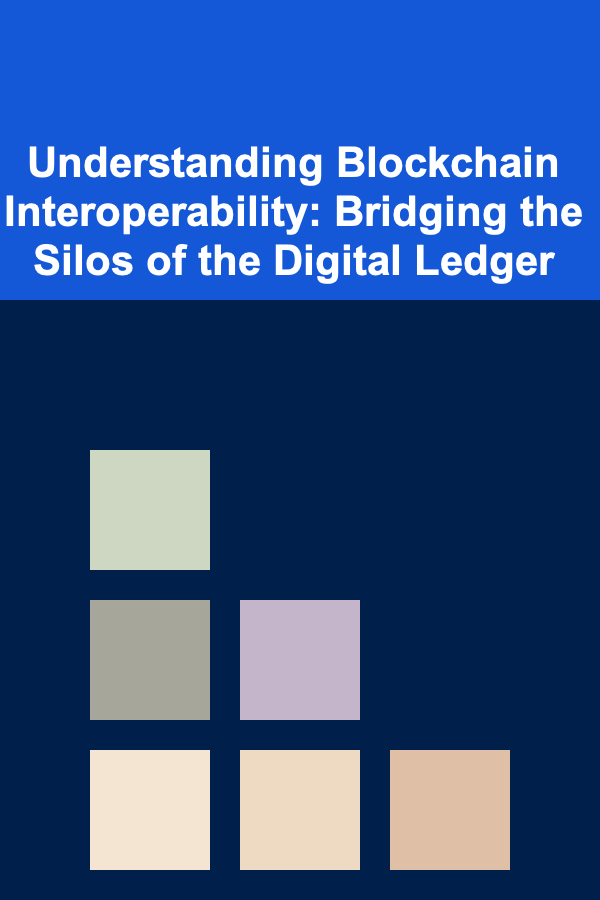
Understanding Blockchain Interoperability: Bridging the Silos of the Digital Ledger
ebook include PDF & Audio bundle (Micro Guide)
$12.99$8.99
Limited Time Offer! Order within the next:

The blockchain ecosystem, while revolutionary, is currently fragmented. Numerous blockchains exist, each with its own consensus mechanisms, data structures, and governance models. This fragmentation creates silos, limiting the potential of blockchain technology. Blockchain interoperability aims to solve this problem by enabling different blockchains to communicate, share data, and transact with each other seamlessly. Understanding the intricacies of blockchain interoperability is crucial for anyone looking to navigate and contribute to the future of this transformative technology. This article delves into the challenges, solutions, and the far-reaching implications of blockchain interoperability.
The Challenge of Blockchain Silos
The proliferation of blockchains, each designed for specific use cases, has led to a disconnected landscape. Consider these challenges:
- Lack of Communication: Blockchains, by default, cannot directly interact with each other. One blockchain has no inherent knowledge of the state or data held on another. This isolation prevents the creation of applications that require accessing or manipulating data across multiple chains.
- Limited Scalability: While individual blockchains strive for scalability, the overall ecosystem remains limited by the inability to distribute workloads across multiple chains. Interoperability allows for data and transaction sharding across different blockchains, potentially improving overall scalability.
- Restricted Innovation: The siloed nature of blockchains hinders innovation. Developers are often forced to choose a single blockchain for their applications, limiting their ability to leverage the unique features and functionalities of other chains. Interoperability unlocks the possibility of hybrid applications that combine the strengths of different blockchains.
- Increased Complexity: Navigating the current blockchain landscape can be overwhelming. Users often need to manage multiple wallets, accounts, and tokens to interact with different applications. Interoperability simplifies the user experience by providing a unified interface for accessing various blockchain services.
- Vendor Lock-in: Being tied to a single blockchain platform can limit flexibility and increase the risk of vendor lock-in. Interoperability promotes competition and allows users to seamlessly migrate between different chains.
Types of Interoperability Solutions
Various approaches are being developed to address the challenge of blockchain interoperability. These solutions can be broadly categorized into the following types:
1. Notary Schemes
Notary schemes, also known as relay chains or federation schemes, rely on a trusted third party (or a set of parties) to verify and relay information between blockchains. These parties act as notaries, attesting to the validity of transactions or data on one blockchain before they are mirrored on another. This is a relatively simple approach, but it introduces a trust dependency on the notaries.
How it works:
- A user initiates a transaction on Blockchain A.
- The notary observes the transaction and verifies its validity.
- The notary then creates a corresponding transaction on Blockchain B, effectively transferring the asset or data.
Examples: Ripple (XRP Ledger), BTC Relay (early Bitcoin bridging project).
Advantages:
- Relatively easy to implement.
- Can be used to connect blockchains with different consensus mechanisms.
Disadvantages:
- Centralized trust model, susceptible to collusion or compromise of the notaries.
- Limited scalability as the notaries become bottlenecks.
- Potential for high transaction fees charged by the notaries.
2. Hashlocking (Atomic Swaps)
Hashlocking, or Hashed Timelock Contracts (HTLCs), allows for the atomic exchange of assets between two blockchains without relying on a trusted intermediary. The transaction is conditional on revealing a secret, ensuring that either both parties receive their respective assets or neither party does. This creates trustless swaps but typically requires both blockchains to support similar scripting capabilities.
How it works:
- Alice wants to exchange tokens on Blockchain A for tokens on Blockchain B with Bob.
- Alice generates a secret and a hash of that secret.
- Alice creates a transaction on Blockchain A, locking her tokens with the hash of the secret. This transaction includes a timelock, specifying a deadline for Bob to claim the tokens.
- Alice shares the hash of the secret with Bob.
- Bob creates a transaction on Blockchain B, locking his tokens with the same hash of the secret and a timelock.
- Bob claims Alice's tokens on Blockchain A by providing the secret.
- Once Bob claims Alice's tokens, Alice can then claim Bob's tokens on Blockchain B by using the same secret.
- If either party fails to claim the tokens within the timelock period, the locked tokens are returned to their original owners.
Examples: Lightning Network (for Bitcoin), cross-chain swaps on various decentralized exchanges.
Advantages:
- Trustless, no reliance on intermediaries.
- Atomic, ensuring that either both parties receive their assets or neither does.
Disadvantages:
- Requires both blockchains to support hashlocking and timelock functionalities.
- Can be complex to implement and requires careful synchronization.
- Not suitable for complex interactions beyond simple asset swaps.
3. Sidechains/Parachains
Sidechains are independent blockchains that are linked to a mainchain (parent chain) through a two-way peg. They have their own consensus mechanisms and can be customized for specific use cases. Parachains, used in the Polkadot ecosystem, are similar to sidechains but benefit from the shared security and interoperability features of the Polkadot relay chain.
How it works:
- A user wants to move assets from the mainchain to a sidechain.
- The user locks their assets on the mainchain in a designated contract.
- An equivalent amount of assets is created on the sidechain, representing the user's assets on the mainchain.
- The user can then use their assets on the sidechain for its specific functionalities.
- To move assets back to the mainchain, the user destroys the assets on the sidechain, and the locked assets on the mainchain are released.
Examples: Rootstock (RSK) for Bitcoin, Polkadot parachains, Cosmos zones.
Advantages:
- Scalability by offloading transactions and data from the mainchain to sidechains.
- Customizability, allowing sidechains to implement specific features and consensus mechanisms.
- Improved performance compared to directly interacting with the mainchain.
Disadvantages:
- Requires designing and maintaining separate blockchains.
- Security vulnerabilities in the sidechain can affect the entire system.
- Can be complex to implement and manage the two-way peg.
4. Relays (Messaging Protocols)
Relays utilize messaging protocols to facilitate communication between blockchains. They focus on transferring information about the state or events occurring on one blockchain to another, enabling cross-chain smart contracts and decentralized applications. This allows for richer interactions compared to simple asset transfers.
How it works:
- An event occurs on Blockchain A (e.g., a smart contract is executed).
- A relay network observes this event and verifies its validity.
- The relay network transmits a message containing information about the event to Blockchain B.
- A smart contract on Blockchain B receives the message and acts upon the information, triggering a corresponding action.
Examples: Chainlink (decentralized oracle network), LayerZero, Wormhole.
Advantages:
- Enables complex cross-chain interactions beyond simple asset transfers.
- Can be used to build cross-chain smart contracts and decentralized applications.
- Potentially more scalable than notary schemes, as relay networks can be decentralized.
Disadvantages:
- Relies on the security and reliability of the relay network.
- Potential for latency and data synchronization issues.
- Complexity in designing and implementing secure and reliable relay networks.
5. Blockchain of Blockchains (Metaverse Protocols)
These protocols aim to create a unified platform that connects multiple blockchains, allowing them to interact and share resources seamlessly. They often involve a central "blockchain of blockchains" that manages the connections and facilitates communication between the connected chains. This approach seeks to provide a comprehensive and interoperable ecosystem.
How it works:
- Each connected blockchain registers itself with the "blockchain of blockchains."
- When a transaction needs to occur between two blockchains, the "blockchain of blockchains" facilitates the communication and coordination.
- Assets and data can be transferred between blockchains through standardized protocols and interfaces.
Examples: Hyperledger Fabric (framework for building private blockchains), potentially emerging metaverse blockchain solutions.
Advantages:
- Provides a unified platform for interoperability between multiple blockchains.
- Simplifies the development of cross-chain applications.
- Can support a wide range of interoperability scenarios.
Disadvantages:
- Can be complex to design and implement a secure and scalable "blockchain of blockchains."
- Potential for centralization if the "blockchain of blockchains" is not sufficiently decentralized.
- Requires standardization of protocols and interfaces, which can be challenging to achieve.
Key Considerations for Interoperability Solutions
When evaluating and selecting interoperability solutions, several key factors should be considered:
- Security: The security of the interoperability solution is paramount. It should not introduce new vulnerabilities or compromise the security of the connected blockchains. Consider the trust assumptions, the attack surface, and the robustness of the solution against various threats.
- Trustlessness: Ideally, interoperability solutions should minimize the reliance on trusted intermediaries. Trustless solutions offer greater security and transparency. However, achieving complete trustlessness can be challenging and may come with trade-offs in performance and complexity.
- Scalability: The interoperability solution should be scalable to handle a large number of transactions and blockchains. Bottlenecks and limitations in scalability can hinder the adoption and effectiveness of the solution.
- Cost: The cost of using the interoperability solution, including transaction fees and infrastructure costs, should be reasonable and competitive. High costs can discourage users and limit the economic viability of cross-chain applications.
- Latency: The time it takes for data and transactions to be transferred between blockchains should be minimized. High latency can negatively impact the user experience and limit the real-time applications that can be built.
- Complexity: The complexity of implementing and using the interoperability solution should be minimized. A simple and intuitive solution will be more easily adopted by developers and users.
- Flexibility: The interoperability solution should be flexible enough to support a wide range of blockchains and use cases. It should be able to adapt to evolving standards and technologies.
- Governance: The governance of the interoperability solution should be transparent and decentralized. A well-defined governance process ensures that the solution is maintained and updated in a fair and equitable manner.
The Future of Blockchain Interoperability
Blockchain interoperability is still in its early stages, but it has the potential to revolutionize the blockchain ecosystem. As the technology matures, we can expect to see:
- Increased Adoption: More and more blockchains will adopt interoperability solutions, enabling seamless communication and collaboration.
- Standardization: Standardized protocols and interfaces will emerge, simplifying the development of cross-chain applications and promoting interoperability between different solutions.
- Advanced Use Cases: New and innovative use cases will emerge, leveraging the power of cross-chain interactions. Examples include cross-chain decentralized finance (DeFi), cross-chain data marketplaces, and cross-chain supply chain management.
- Improved User Experience: User-friendly interfaces and tools will be developed, making it easier for users to interact with multiple blockchains.
- Greater Scalability: Interoperability will contribute to improved scalability of the overall blockchain ecosystem by distributing workloads across multiple chains.
- Enhanced Security: Security will continue to be a top priority, with ongoing research and development focused on building more robust and secure interoperability solutions.
Impact on Specific Industries
Blockchain interoperability has the potential to impact a wide range of industries:
- Finance (DeFi): Enabling seamless asset transfers and complex financial instruments across different blockchains, leading to increased liquidity and efficiency.
- Supply Chain Management: Tracking products and materials across multiple blockchains, improving transparency and traceability.
- Healthcare: Sharing patient data securely and efficiently across different healthcare providers, improving patient care and research.
- Gaming: Allowing players to use their in-game assets across different games, creating a more immersive and engaging gaming experience.
- Identity Management: Verifying identities and credentials across multiple blockchains, simplifying the process of accessing services and reducing fraud.
- Government: Improving transparency and efficiency in government processes, such as voting and land registration.
Conclusion
Blockchain interoperability is essential for realizing the full potential of blockchain technology. By bridging the silos of the digital ledger, it enables seamless communication, data sharing, and transaction execution across different blockchains. While various challenges remain, the ongoing development of interoperability solutions promises a more connected, scalable, and innovative blockchain ecosystem. Understanding the different types of interoperability solutions, the key considerations for evaluating them, and the potential impact on various industries is crucial for anyone looking to navigate and contribute to the future of blockchain.

Creative Vision: A Graphic Designer's Approach to Innovative Design
Read More
How to Create a Family Recipe Book Together
Read More
How to Create a Stylish and Organized Vanity Area
Read More
How to Incorporate Modern Design Elements in Your Home Renovation
Read More
How to Enhance Your Problem-Solving Speed with Brain Hacks
Read More
Exploring DNA Forensics and Paternity Testing
Read MoreOther Products

Creative Vision: A Graphic Designer's Approach to Innovative Design
Read More
How to Create a Family Recipe Book Together
Read More
How to Create a Stylish and Organized Vanity Area
Read More
How to Incorporate Modern Design Elements in Your Home Renovation
Read More
How to Enhance Your Problem-Solving Speed with Brain Hacks
Read More